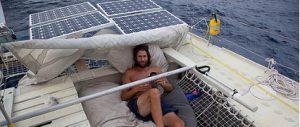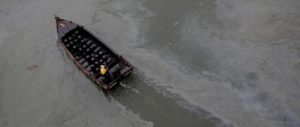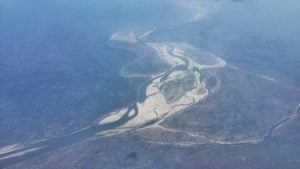As terrestrial creatures, we seldom give much thought to the fact that seven-tenths of the planet are covered in water averaging about four kilometres deep. When we do, we tend to think of the oceans as trade routes, joining one piece of land to another, or as places from which we extract seafood and into which we dump waste.
For almost all of human history, we have been able to rely on these services without thinking (not to mention others that, until recently, we weren’t aware of, such as that oceans provide us with about half the oxygen we breathe). We can no longer afford to behave in this way.
The rapid growth in human population over the last century and the increasing pace and scale of industrial activity and consumption is changing the oceans faster than at any time in human history, and probably any time since the catastrophe that wiped out the dinosaurs 65 million years ago. We are the cause of that transformation.
The changes bring opportunities. In the last decade, the melting of Arctic Sea ice has opened a connection between the Pacific and Atlantic oceans that had been shut for 800,000 years. New seaways for trade and new sources of oil and gas are appearing. But the changes also bring huge challenges that threaten to outweigh the gains unless communities and nations address them in something like what experts call a New Deal for the Oceans (see "Books: An unsettling ocean view" for more on the work of one of these experts, marine conservation biologist Callum Roberts).
In the past century, the variety and abundance of ocean life have been greatly reduced by overfishing and a cocktail of man-made stresses, particularly pollution. The rate of loss is increasing. Because of the overwhelming influence that the oceans have in the processes that define our planet, these losses not only threaten marine life but place human wellbeing itself in jeopardy. To survive the growing crisis, we need a radical overhaul of our relations with the sea, shifting from overuse and misuse to better stewardship and smart exploitation. Marine biologists suggest the following as the minimum necessary:
* Reduce fishing pressure in most ecosystems (at least a halving of pressure in general) and an outright ban on fishing below 800 metres.
* Phase out of the most destructive fishing gear, such as bottom trawls and dredges in most areas.
* Expand marine reserves to cover one third of the oceans. Reserve networks must include hotspots of biodiversity and places rich in unique life forms, and include the most likely long-term refuges from climate-related stresses.
* Reduce inputs of toxic substances and plastics.
* Clean up plastics in the ocean “garbage patches”, and on coasts and the seabed.
* Reduce nutrient inputs and sediment runoff.
* End the net loss of coastal wetlands and restore places worst affected by habitat loss.
* Wherever possible, adopt “soft” engineering approaches to coastal protection and restoration (in other words, work with natural and biological processes rather than concrete).
* Reduce greenhouse-gas emissions and switch to non-polluting, renewable sources of energy.
Among the greatest challenges is overfishing. This has reduced the abundance of the fish we most like to eat to a tenth of their numbers a century ago, forcing fisherman to travel to ever more remote areas and use ever more destructive techniques to take what remains, thereby undermining the ability of stocks to recover.
Another is the massive quantity of sewage and fertilisers and other materials from agriculture that escape into coastal waters every day, leading to phenomenon such as toxic algal “red tides” and overgrowth of seaweed that chokes formerly healthy and productive ecosystems. Humans also burden the seas with enormous quantities of carcinogens and toxins such as mercury (much of it from the combustion of coal) and brominated flame-retardants, which work their way into every part of the food chain, including humans who eat fish from the sea.
Global warming is causing sea levels to rise faster than the highest rates predicted by the Intergovernmental Panel on Climate Change (IPCC) 20 years ago. The entire ocean could be more than a metre higher by the year 2100. Since extremely low-lying coastal areas contain some of the world’s richest farmland and most populous cities, hundreds of millions of people and the world’s food supplies are at grave risk.
A pointer to what could happen to life beneath the sea came in 1998, when the Indian Ocean became so hot that three quarters of its corals died. It was as if three quarters of forest trees on the Asian continent had withered in a single year, and yet few people outside the specialised world of marine science seemed to notice. Years as hot as 1998 are likely to be the norm by the middle of the century.
When we release carbon dioxide into the atmosphere, much of it dissolves in the ocean. If this were happening slowly, there would be no cause for concern because the oceans would be able to buffer the slight change in acidity caused by the presence of extra carbon dioxide. But the rate of change arising from human emissions is some 50 times faster than anything that has happened in at least 55 million years, and perhaps in all of Earth’s history. The consequences of acidification are unclear, but at the least it is likely that organisms that make calcareous skeletons (which include corals and shellfish) will be adversely affected. The impact on ocean ecosystems could be catastrophic.
In a moment of pessimism, the British mathematician and philosopher Betrand Russell once said that “most people would rather die than think; in fact, they do so.” We must face up to these and other challenges if we are to avoid disaster and sustain the hopes and aspirations for our children and grandchildren that we have for ourselves. Today, World Oceans Day, would be a good time to start.
Caspar Henderson is a writer and journalist on environmental affairs.
Homepage image by Cara StHilaire



